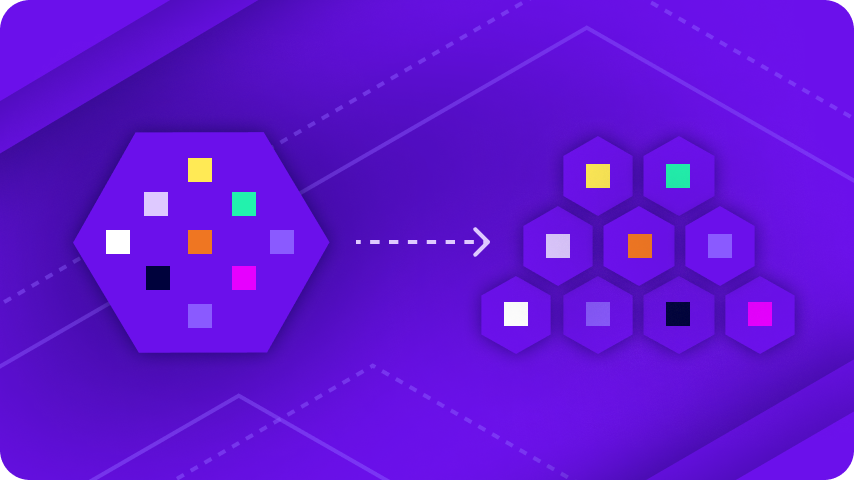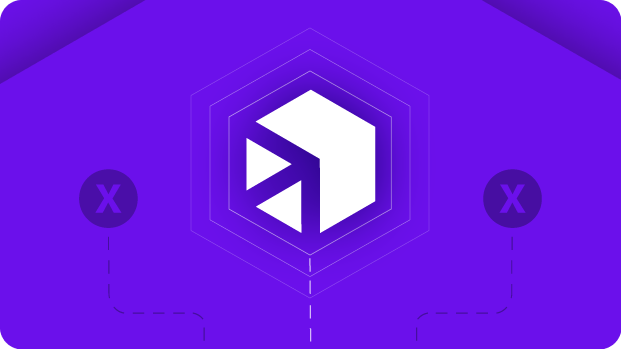June 19, 2024
Ah, APIs. Eles são os fios invisíveis que entrelaçam a estrutura de nossas vidas tecnológicas. No entanto, construí-los consome um terço do nosso tempo de codificação e, de acordo com um relatório da Postman, em 61% das vezes eles são usados apenas para fins internos. Podemos arcar com todo o tempo, o talento e o esforço necessários para construir APIs monolíticas?
A resposta curta geralmente é não.
O que é uma API monolítica e por que você deveria se importar?
API significa Application Programming Interface. Imagine uma API monolítica como um grande e complexo castelo de Lego onde todos os componentes são fortemente interconectados, com cada peça dependendo da anterior e impactando a próxima.
A vantagem de construir APIs é que elas promovem consistência e facilitam o trabalho em equipe. No entanto, atualizar ou corrigir problemas geralmente requer abordar todo o programa, o que pode ser complicado e demorado, principalmente se o desenvolvedor original não estiver mais na organização.
Além de construir e manter a API, também há preocupações relacionadas a testes, segurança, escalabilidade, configuração e monitoramento. Embora as ferramentas de gerenciamento de API ajudem a simplificar as operações, dedicar tempo ao gerenciamento de APIs internas que não geram receita pode não ser o uso mais eficiente dos recursos.
>> Agende uma demonstração personalizada com nossa equipe de especialistas e veja como o iPaaS da Digibee trará eficiência ao seu negócio.
APIs internas versus externas
APIs internas
APIs internas, também conhecidas como APIs privadas, são projetadas para serem acessíveis apenas dentro da organização. Eles normalmente têm acesso restrito, são desenvolvidos para agilizar as operações e reduzir a necessidade de intervenção manual. São utilizados para integração de sistemas e aplicações, promovendo interoperabilidade e compartilhamento de dados dentro da empresa.
APIs externas
APIs externas, por outro lado, são acessíveis ao público em geral ou a desenvolvedores externos. Essas APIs melhoram os recursos, a eficiência e o alcance de aplicações e serviços. Elas normalmente são usadas por clientes ou parceiros para melhorar a experiência do usuário, fornecer acesso a dados em tempo real e permitir integrações perfeitas. Às vezes, essas APIs podem até se tornar uma fonte de receita.
Os prós e contras das APIs monolíticas
APIs monolíticas funcionam como uma unidade única e coesa que expõe a funcionalidade de toda a aplicação. Quando usadas como ferramentas de geração de receita, oferecem vantagens significativas: simplicidade, desempenho e consistência. No entanto, para uso interno, as restrições de uma estrutura monolítica podem criar riscos, retardar o progresso e limitar a flexibilidade e a escalabilidade.
Prós de APIs monolíticas
- Simplicidade: o desenvolvimento e a implantação podem ser mais simples porque tudo está contido em uma única base de código.
- Desempenho: A comunicação entre componentes em um aplicativo monolítico pode ser mais rápida, pois ocorre no mesmo processo.
- Consistência: Manter uma base de código única e unificada pode garantir um comportamento consistente e uma depuração mais fácil.
Contras de APIs monolíticas
- Desafios de Escalabilidade: Escalar componentes específicos de forma independente é difícil, pois toda a aplicação precisa ser escalada.
- Risco de implementação: A implantação de atualizações é mais arriscada e demorada, porque todo o aplicativo deve ser reimplantado, aumentando a chance de tempo de inatividade.
- Gargalos de desenvolvimento: Equipes grandes trabalhando na mesma base de código podem levar a dificuldades de coordenação e ciclos de desenvolvimento mais lentos.
- Complexidade de manutenção: Com o tempo, a base de código se torna grande e pesada, deixando a manutenção e o controle de versão mais complexos.
- Flexibilidade Limitada: A adaptação a novas tecnologias ou padrões de arquitetura é mais desafiadora, devido à natureza fortemente acoplada do sistema.
Cenário com uma API monolítica interna
Imagine uma grande empresa com uma API monolítica interna usada por vários departamentos para gerenciamento de funcionários, folha de pagamento e acompanhamento de projetos. A API integra múltiplas funcionalidades, como tratamento de dados confidenciais de funcionários, processamento de folha de pagamento e gerenciamento de atribuições de projetos, tudo em um único aplicativo conectado.
Agora, imagine que o departamento de RH solicite uma atualização urgente do módulo de processamento de folha de pagamento para cumprir as novas regulamentações governamentais que exigem campos de dados adicionais para relatórios fiscais. No entanto, as funcionalidades de gerenciamento de funcionários e rastreamento de projetos também estão fortemente integradas na mesma API monolítica.
Com uma estrutura de API monolítica, ocorrem os seguintes desafios:
Risco de implementação
- Unidade única de implementação: Como a API é monolítica, atualizar o módulo de processamento de folha de pagamento exige a reimplementação de toda a aplicação. Isso significa que qualquer alteração, mesmo aquelas não relacionadas à folha de pagamento, pode potencialmente introduzir erros ou problemas nos módulos de gestão de funcionários ou de acompanhamento de projetos.
- Versionamento: Gerenciar o suporte para diferentes versões e implementar várias versões cria riscos tanto para a segurança quanto para possíveis resultados indesejados ao utilizar duas chamadas de API distintas.
Complexidade de Testes
- Cuidado integral Testing: A equipe de desenvolvimento precisa testar toda a aplicação, e não apenas o módulo de folha de pagamento, para garantir que as alterações não impactem negativamente outras partes do sistema. Isso aumenta o escopo e o tempo de testes necessários antes da implantação.
Coordenação
- Impacto interdepartamental: A alteração exige coordenação entre várias equipes, incluindo RH, TI e finanças. Qualquer atraso ou falha de comunicação pode desacelerar o processo de atualização, causando problemas de conformidade com as novas regulamentações.
Dívida Técnica
- Emaranhamento de código: A natureza monolítica da API pode levar a um código emaranhado, onde diferentes funcionalidades são interdependentes. Modificar uma parte pode afetar outras inadvertidamente, tornando o sistema mais frágil e difícil de manter ao longo do tempo.
Gargalo do desenvolvedor
- Alocação de recursos: A equipe de desenvolvimento pode ficar sobrecarregada, já que precisa se concentrar em entender e modificar uma base de código extensa. Isso pode desacelerar o processo de atualização e impactar outros projetos em andamento.
Neste cenário, a infraestrutura monolítica de API tem as seguintes consequências:
- Conformidade atrasada: O atraso na atualização do módulo de folha de pagamento pode levar a não conformidade com regulamentações governamentais, resultando em possíveis multas ou problemas legais.
- Produtividade Reduzida: O tempo de inatividade e as interrupções afetam vários departamentos, reduzindo a produtividade e a eficiência gerais.
- Aumento da Frustração: A equipe de TI enfrenta maior pressão e frustração devido à complexidade e ao risco envolvido em fazer alterações na API monolítica
A natureza fortemente acoplada da API monolítica cria desafios significativos em termos de implementação, testes, coordenação e manutenção, que impactam o orçamento. Assim, ficam claros os potenciais problemas das arquiteturas monolíticas em ambientes dinâmicos e de grande escala.
O caminho a seguir
APIs monolíticas são fortemente integradas às suas aplicações, e embora possam oferecer simplicidade e benefícios de desempenho, também apresentam desafios significativos em escalabilidade, implantação e manutenção. Como resultado, muitas organizações estão migrando para arquiteturas de microsserviços, onde as APIs são mais modulares e podem ser desenvolvidas, implantadas e escaladas de forma independente.
A Plataforma de Integração Digibee resolve isso usando funções sem servidor chamadas Capsules, que agem como código reutilizável sem precisar de uma API exposta. Essa abordagem elimina a necessidade de medidas de segurança, dimensionamento individual e monitoramento para APIs internas. Veja as Cápsulas em ação:
As Cápsulas podem ser chamadas a qualquer momento em um fluxo de integração. Além disso, combinar várias Cápsulas em uma única API para uso externo é simples: basta colocá-las no mesmo fluxo com um gatilho de API (endpoint) usando uma ação de drag-and-drop, sem precisar de uma reconstrução. Esse método economiza tempo e recursos, permitindo uma inovação e diferenciação mais rápidas para as organizações.
Pronto para agilizar sua estratégia de integração? Entre em contato com nossa equipe hoje mesmo para descobrir como a Digibee simplifica a arquitetura orientada por API, acelera integrações e economiza dinheiro e recursos.








